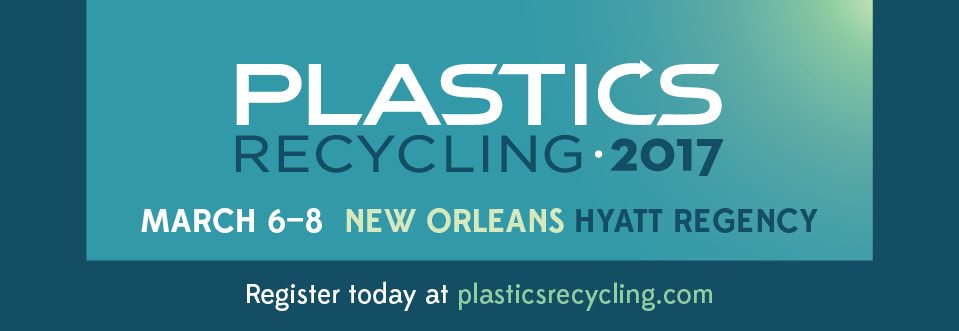
Nina Goodrich, Sustainable Packaging Coalition
As Plastics Recycling 2017 approaches, we’re offering a series of conversations with industry leaders who will be taking to the stage in New Orleans. This week, the leader of the Sustainable Packaging Coalition sheds light on the ways recycling can tie into larger trends in the packaging realm.
Nina Goodrich is the executive director of GreenBlue, a nonprofit group that includes the Sustainable Packaging Coalition. A big part of her role is helping the packaging industry align itself with sustainable materials management (SMM), a strategy in which material choices are made based on the environmental impacts associated with the entire life cycle of a product.
At Plastics Recycling 2017, she’ll be participating in the opening plenary session on Tuesday, March 7, which will focus on moving from sustainability buzzwords to best practices.
In what ways is the traditional thinking about packaging recycling no longer holding up?
Too much of our current conversation centers on waste diversion. We have to stop thinking about packaging materials as mostly waste. There is a core of materials that are well suited to quality recycling. What can we do to increase the value and reduce the contamination of these core materials? How do we create a value proposition that drives itself?
New 2025 goals from select brand owners and retailers are starting to reflect bold reusable, recyclable and compostable criteria. This is a start, but we also have to change the way we view these core materials. Designing packaging for recovery needs to become a goal. Many materials start out well but are compromised along the way to becoming a package. Better design is essential to create a valuable supply chain.
Sustainable materials management and circular economy are two strategies we hear a lot about but not always with definitions. How would you characterize each of them and how do they fit together or conflict?
As an organization, our work aligns with the principles of both sustainable materials management and the circular economy. But I believe the working philosophies of both sets of principles have been set against each other in ways that were never intended. These philosophical approaches are not mutually exclusive and it should not be one versus the other. We need simultaneous application of both philosophies.
We need packaging that is recoverable and made with renewable or recycled materials. That doesn’t mean we don’t also focus on improving impact measurements like carbon over the life cycle. The converse is just as true. Low life-cycle impacts should never be used as justification for poor — or nonexistent — recovery rates. The best packaging is going to have low life cycle impacts, aligning with the principles of SMM, and it’s also going to have circularity at its end-of-life and beginning-of-life, aligning with the principles of the circular economy. It has to be both.
As an organization, our work aligns with the principles of both sustainable materials management and the circular economy. But I believe the working philosophies of both sets of principles have been set against each other in ways that were never intended.
What concrete steps can recycling stakeholders take to align themselves with SMM thinking?
Sustainable materials management is about improving the sustainability of products throughout their entire life cycles and making the materials economy function more efficiently and effectively. Looking at recycling with a sustainable materials mindset means shifting our focus away from traditional approaches to fixing the recycling system, like narrowly focusing on outreach and education, and using a broader set of solutions that work in combination with one another. This means helping consumers understand what and how to recycle, but it also means taking steps to improve the quality of commodities sold to end markets, creating understanding among brands about what materials can be successful in the recycling system and harmonizing packaging design with the recycling system. And it’s not just about using recycling as a means for reducing carbon footprints. The principles of the circular economy tell us that recycling and the creation of recycled content is a worthwhile endeavor in itself.
When we think of SMM, we view a few underlying elements of performance: material design, material sourcing, material health and material recovery. With recovery, unfortunately, we don’t see enough industry focus on using design-for-recycling principles from the start. Products like PET and PE can start out well, but their recyclability can be compromised through poor labels, adhesives and colors.
What’s the most exciting part of working in the world of plastics and packaging recovery right now?
For me, it’s seeing the new wave of corporate goals that include 100 percent recyclable. We are working to develop the How2Recycle label system to help brands and retailers that want to measure their performance against these new goals. The How2Recycle label can not only help a brand tell a story within its newer recyclability goals, but can also help that brand benchmark where their packaging currently is and where it needs to go in order to be optimally recyclable.
Many companies make the surface-level assumption on their own that their packaging is recyclable, when in reality, they may have added labels, adhesives, coatings or additives to it, or designed it in a certain way that it’s not quite as recyclable as they think. Behind each package featuring the label is a custom recyclability assessment; we collaborate with industry experts like the Association of Plastic Recyclers and Recycled Paperboard Alliance to be sure that the label is as precise and accurate as possible. As a result, How2Recycle members say the program sparks internal conversations in their company about recyclability, broadens their perspective on material and format choices for packaging, and provides avenues to innovate packaging to be more recyclable.
As exciting as this is, it would be even better if we started to see goals for recycled content or goals creating market pull for other durable items made from recycled content.
Get more industry insight from Goodrich and the other exciting session speakers at Plastics Recycling 2017, set for March 6-8 at the Hyatt Regency New Orleans. Get all the latest conference info at plasticsrecycling.com.


